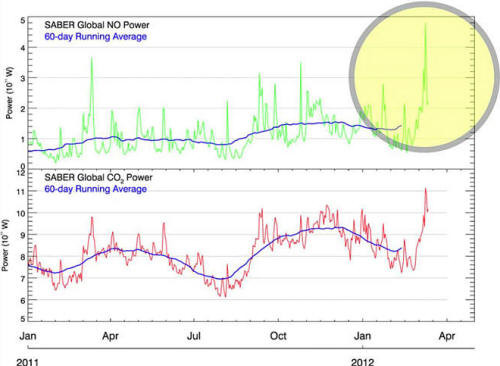|
This story was retrieved from non-copyrighted material
on the NASA website. Neither NASA
nor any other federal agency endorses the Telescope & Sky website.
Earth's atmosphere lights up at infrared wavelengths during the solar storms
of March 8-10, 2012. This ScienceCast video explains the physics of this phenomenon.
Credit:
Science@NASA . Original Story
here.
| Earth's atmosphere lights up at infrared wavelengths during the solar
storms of March 8-10, 2012. This ScienceCast video explains the physics of this
phenomenon. Credit: Science@NASA |
› Download video
A recent flurry of eruptions on the sun did more than spark pretty auroras around
the poles. NASA-funded researchers say the solar storms of March 8th through 10th
dumped enough energy in Earth’s upper atmosphere to power every residence in New
York City for two years.
“This was the biggest dose of heat we’ve received from a solar storm since 2005,”
says Martin Mlynczak of NASA Langley Research Center. “It was a big event, and shows
how solar activity can directly affect our planet.” Mlynczak is the associate
principal investigator for the SABER instrument onboard NASA’s TIMED satellite.
SABER monitors infrared emissions from Earth’s upper atmosphere, in particular from
carbon dioxide (CO2) and nitric oxide (NO), two substances that play a key role
in the energy balance of air hundreds of km above our planet’s surface. “Carbon
dioxide and nitric oxide are natural thermostats,” explains James Russell of Hampton
University, SABER’s principal investigator. “When the upper atmosphere (or ‘thermosphere’)
heats up, these molecules try as hard as they can to shed that heat back into space.”
That’s what happened on March 8th when a coronal mass ejection (CME) propelled
in our direction by an X5-class solar flare hit Earth’s magnetic field. (On the
“Richter Scale of Solar Flares,” X-class flares are the most powerful kind.) Energetic
particles rained down on the upper atmosphere, depositing their energy where they
hit. The action produced spectacular auroras around the poles and significant1 upper
atmospheric heating all around the globe. “The thermosphere lit up like a
Christmas tree,” says Russell. “It began to glow intensely at infrared wavelengths
as the thermostat effect kicked in.” For the three day period, March 8th
through 10th, the thermosphere absorbed 26 billion kWh of energy. Infrared radiation
from CO2 and NO, the two most efficient coolants in the thermosphere, re-radiated
95% of that total back into space.

› View larger
A surge of infrared radiation from nitric oxide molecules on March 8-10, 2012,
signals the biggest upper-atmospheric heating event in seven years. Credit: SABER/TIMED.
In human terms, this is a lot of energy. According to the New York City
mayor’s office, an average NY household consumes just under 4700 kWh annually. This
means the geomagnetic storm dumped enough energy into the atmosphere to power every
home in the Big Apple for two years. “Unfortunately, there’s no practical
way to harness this kind of energy,” says Mlynczak. “It’s so diffuse and out of
reach high above Earth’s surface. Plus, the majority of it has been sent back into
space by the action of CO2 and NO.” During the heating impulse, the thermosphere
puffed up like a marshmallow held over a campfire, temporarily increasing the drag
on low-orbiting satellites. This is both good and bad. On the one hand, extra drag
helps clear space junk out of Earth orbit. On the other hand, it decreases the lifetime
of useful satellites by bringing them closer to the day of re-entry. The
storm is over now, but Russell and Mlynczak expect more to come. “We’re just
emerging from a deep solar minimum,” says Russell. “The solar cycle is gaining strength
with a maximum expected in 2013.” More sunspots flinging more CMEs toward
Earth adds up to more opportunities for SABER to study the heating effect of solar
storms. “This is a new frontier in the sun-Earth connection,” says Mlynczak,
and the data we’re collecting are unprecedented.” Dr. Tony Phillips Science@NASA
Posted March 31, 2012
|